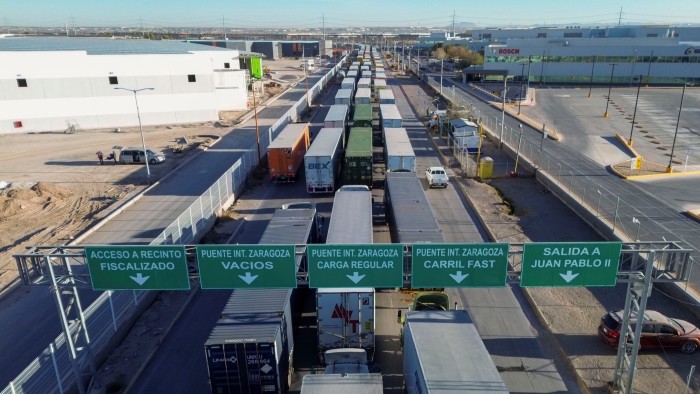Auto Industry Faces Shift: Trump’s Tariffs Could Propel Manufacturing to Asia
The looming tariffs proposed by former President Donald Trump on imports from Mexico are raising significant concerns within the automotive industry. As a leading car parts manufacturer recently warned, these tariffs could catalyze a substantial shift in automotive production from the United States to Asia. This potential shift not only threatens the stability of American jobs but also poses challenging questions about the future of local manufacturing.
The Impending Tariffs and Their Implications
In recent months, discussions surrounding tariffs have reignited, particularly concerning Mexico, which has become a crucial manufacturing hub for American automakers. With a myriad of auto parts and assembly operations established in Mexico, the proposed tariffs could dramatically increase production costs for American companies. This increase in costs could drive manufacturers to consider relocating their operations to Asian countries where labor and production costs are often lower.
For instance, countries like Vietnam, Thailand, and even China have increasingly become attractive options for manufacturing due to their competitive labor prices and established automotive supply chains. If tariffs on Mexican imports become a reality, manufacturers may find themselves weighing the benefits of relocating to these Asian markets against the rising costs of continuing operations in Mexico.
Job Losses and Economic Impact
One of the most immediate concerns regarding this potential shift is the impact on American jobs. The automotive sector is a significant employer in the U.S., supporting millions of jobs both directly and indirectly. The transition of manufacturing jobs to Asia could lead to:
- Massive Job Losses: With production moving overseas, American workers in manufacturing, assembly, and related sectors could face layoffs or reduced job opportunities.
- Economic Decline in Manufacturing Hubs: Areas heavily reliant on the automotive industry, such as Detroit, could experience economic downturns, affecting local businesses and tax revenues.
- Skill Drain: As jobs move abroad, a generation of skilled workers may find themselves out of work, leading to a loss of valuable expertise in the U.S. manufacturing landscape.
Furthermore, the ripple effects of job losses extend beyond the automotive sector. Industries providing materials, technology, research, and development will also feel the strain, potentially leading to a wider economic impact.
Shifting Manufacturing Strategies
In light of these concerns, many automotive companies are reconsidering their strategies. Manufacturers are now faced with the challenge of balancing cost efficiency with the need to maintain a domestic presence. Some potential strategies include:
- Investing in Automation: To counteract rising labor costs, companies may invest more in automation and advanced manufacturing technologies, allowing them to maintain production levels while reducing reliance on human labor.
- Reshoring Production: Some companies may explore bringing some manufacturing back to the U.S., particularly for high-value components, to avoid tariffs altogether.
- Diversifying Supply Chains: Companies may seek to diversify their supply chains by sourcing materials and components from multiple countries, reducing the risk associated with reliance on a single location.
The Future of American Manufacturing
While the potential shift in automotive manufacturing to Asia due to Trump’s tariffs presents significant challenges, it also opens up opportunities for innovation and adaptation within the American manufacturing landscape. Companies may leverage this situation to rethink their operational models and embrace new technologies.
Moreover, this scenario reiterates the importance of supporting local manufacturing initiatives. Policymakers, industry leaders, and communities must work together to create a favorable environment for domestic manufacturing. This might include:
- Incentivizing Local Production: Governments can provide incentives for companies that choose to keep or bring back manufacturing jobs to the U.S., such as tax breaks or grants.
- Enhancing Workforce Training: Investing in workforce development programs can equip American workers with the skills needed to thrive in an increasingly automated and technology-driven manufacturing environment.
- Strengthening Trade Agreements: Revisiting trade agreements to protect American jobs while fostering fair competition can help stabilize the industry.
Conclusion: Navigating a New Era
The automotive industry stands at a crossroads, with Trump’s proposed tariffs potentially reshaping the landscape of manufacturing in the U.S. The threat of shifting production to Asia highlights the fragility of the current system and emphasizes the need for strategic planning and adaptation. While the challenges are significant, there is also an opportunity for American manufacturers to innovate, invest in technology, and support local economies.
As stakeholders navigate this new era, it is crucial to maintain a focus on resilience and adaptability. The future of the automotive industry may depend on how well it can respond to these challenges and capitalize on new opportunities. By fostering a robust manufacturing environment, the U.S. can not only mitigate the risks associated with these tariffs but also position itself as a leader in the global automotive market.
See more Business Focus Insider Team

